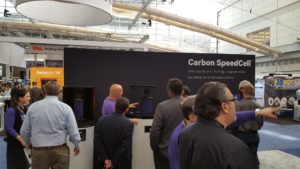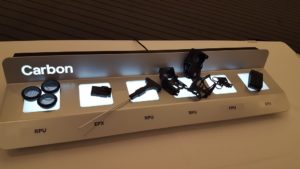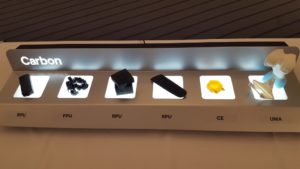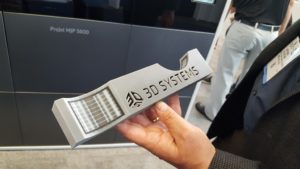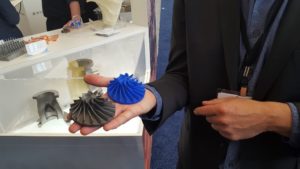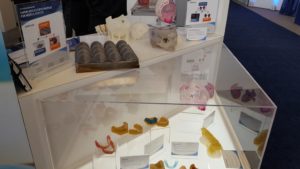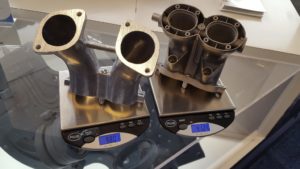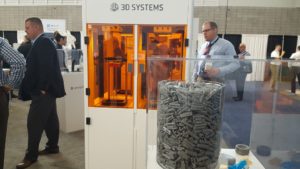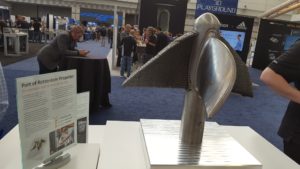 Many events are over as soon as closing time hits, but for some of the biggest shows in the 3D printing calendar year, the conversations continue even weeks thereafter. It’s hard to believe it’s already been three weeks since the last day of RAPID + TCT show, but somewhat less tough to believe that there’s still more to say about what happened this year in Pittsburgh. The show for 2017 was bigger (and better?) than ever before, with thousands of attendees and hundreds of exhibitors. I had the opportunity to catch up and sit down with Carbon, 3D Systems, and Autodesk at RAPID to learn more about what these big-name companies have been up to lately and to see first-hand their most recent announcements.
Many events are over as soon as closing time hits, but for some of the biggest shows in the 3D printing calendar year, the conversations continue even weeks thereafter. It’s hard to believe it’s already been three weeks since the last day of RAPID + TCT show, but somewhat less tough to believe that there’s still more to say about what happened this year in Pittsburgh. The show for 2017 was bigger (and better?) than ever before, with thousands of attendees and hundreds of exhibitors. I had the opportunity to catch up and sit down with Carbon, 3D Systems, and Autodesk at RAPID to learn more about what these big-name companies have been up to lately and to see first-hand their most recent announcements.
Carbon
Carbon has been grabbing headlines since it emerged from stealth two years ago, and lately has made it to mainstream attention as well through a well-publicized ambitious partnership with adidas as 3D printing is set to hit production-scale shoes. The entire Carbon team at the company’s busy booth was wearing their high-tech Futurecraft 4D footwear, and universally pleased to be wearing sneakers at a long event, but I sat down for a quieter chat with Valerie Buckingham, Carbon’s Vice President of Marketing, to hear more directly from her. In the flurry of news coming hard and fast as RAPID kicked off, it was noticeable that the recently very busy Carbon had been pretty quiet in Pittsburgh; this was on purpose, Buckingham explained. The company launched its SpeedCell system at AMUG, including the new M2 3D printer, and knew then that just two weeks after that show would be the adidas announcement — and so the company chose not to do anything big at RAPID, but to showcase what it had just rolled out to give the community the opportunity to see and interact with its latest systems, materials, and, well, shoes.
“The adidas announcement is good because it’s concrete, it’s credible; this is real manufacturing at scale where it has to be amazing, it has to work at scale,” Buckingham told me. “Adidas as a company is so innovative, it’s awesome to focus at Carbon on sharing that customer story. We print the midsoles flat, then bake to shape the curve. The 3D printers used for adidas are bespoke.”
That bit of information does address some of the questions that had arisen about the shoe-printing plans, in that we at least now know they’re using custom systems to create the mass-market footwear. Buckingham continued, noting that the company is “spending a lot of time and a lot of focus on going to production.”
“SpeedCell came about because of huge demand from our customers,” she noted of the new system. “The mission is to bring additive to manufacturing; we’re seeing real, credible manufacturing operations now. The next steps in additive are in how to scale up, how do we get there now that the real heavy lifting is done.”
 So far as plans with adidas are concerned, she explained that they are looking toward a commercial holiday launch. She said that this work puts the human designer in the center, while designing a product that can be bespoke. “Additive,” she said, “is about programming the physical world.”
So far as plans with adidas are concerned, she explained that they are looking toward a commercial holiday launch. She said that this work puts the human designer in the center, while designing a product that can be bespoke. “Additive,” she said, “is about programming the physical world.”
“The point we have been making by saying, ‘Stop prototyping, start producing’ is in making something that can’t be scaled; on this system, design and iteration happen on the same tool used to scale. It’s a paradigm shift. There’s a complete shift to design a product that can be dynamic.”
On another note for the company, Carbon’s CEO and Founder, Dr. Joseph DeSimone, also released a statement today giving further insight into the company’s vision of the future — relying on a diverse set of minds to develop the industry. He wrote, in part:
“In other words, inherent human characteristics shape one’s experience of and in the world, and as a result, influence how individuals view and approach challenges. As an ambitious, forward-looking company, I believe Carbon benefits significantly from the way different problem-solving approaches among our team members come together to generate innovative ideas.
Besides, differences in people are what make humans interesting in the first place and result in the most dynamic and lively discussions—about additive manufacturing, or about anything.”
Later in the piece, he continued, “If 3D printing is going to transform manufacturing, then we must focus on including the greatest range of ideas and perspectives possible. Already, the needs, perspectives, and creativity of our diverse and pioneering partners are illuminating how part production will be transformed in the 21st century. In this context especially, I believe it is crucial to cultivate differences, look outward, and be welcoming of all people. This involves actively countering insularity, intolerance, and discrimination.”
3D Systems
3D Systems didn’t so much have a booth at RAPID this year, as a complex. Segmented into more digestible areas of focus, the company’s display drew attention to specific technologies and applications and my intrepid tour guides showed me through each vertical. On the journey with me were Jim Ruder, SVP and General Manager, Plastics; Patrick Dunne, VP, Advanced Application Development; Derek Johnson, Product Management, MJP; and Diane Parrish, Director, Executive Communications. I had spoken with Ruder ahead of RAPID to learn more about the company’s announcements during the show, and he graciously showed off the new ProJet MJP 5600 and materials, seen for the first time in Pittsburgh.
“The 5600 will be available in June, as our new flagship MJP machine,” Ruder told me. “We’re focusing on optimizing total cost of operations throughout our portfolio. The customer cares for additive manufacturing in real production; equipment, materials, service, and electricity costs are all part of TCO. We’re asking the team to drive there and to scale.”
 TCO has been in focus lately for the company, as 3DS strives to beat the competition on this front, along with workflow enhancements through a focus on software. Among the benefits of the 5600 that Ruder pointed out are:
TCO has been in focus lately for the company, as 3DS strives to beat the competition on this front, along with workflow enhancements through a focus on software. Among the benefits of the 5600 that Ruder pointed out are:
- Voxel-level optimization
- Varied mechanical properties
- New degree of design flexibility and an additional degree of freedom
- Driving materials compatibility
Johnson pointed out of the recently introduced materials that “it’s exciting to print with multi-material capabilities.” The different mechanical properties, he said, extend capabilities, creating a “very versatile toolbox.” One interesting capability is in blending between materials, allowing for an additional range of properties mixing the characteristics of chosen materials. An example he noted was that valves can be printed with integrated gaskets; “this is really a workhorse for engineers,” he said.
As we moved toward other areas of the booth, Dunne pointed to investment casting as an application that has been benefiting greatly from 3D printing technologies. Wax printing, he noted, enhances casting workflows in a two-step process offering “immediate access to traditional alloys as a very efficient way to get metal parts.” On the dental side of the booth, Dunne noted that dentistry is “the largest cottage industry for prostheses made by hand; it’s ripe for automation. Pieces are complex, detailed, and all created as a one-off.”
“It starts with materials,” he said, echoing what 3D Systems CEO Vyomesh Joshi (VJ) has told us before. “We address bio requirements first.”
 He pointed to the NextDent portfolio the company acquired early in the year as 3D printing is used to address areas of “huge demand” such as in dentures. We looked also at other health-related areas, another large area of interest for the company. “Surgeons never want to go back after using 3D printed anatomical models,” Dunne told me as we looked at some of the patient-specific anatomies 3D Systems technologies have helped to create.
He pointed to the NextDent portfolio the company acquired early in the year as 3D printing is used to address areas of “huge demand” such as in dentures. We looked also at other health-related areas, another large area of interest for the company. “Surgeons never want to go back after using 3D printed anatomical models,” Dunne told me as we looked at some of the patient-specific anatomies 3D Systems technologies have helped to create.
Continuing on our tour, we looked to metals, where low-volume boutique automotive applications in particular can benefit from personalization and customization, as well as design optimization lightweighting components for enhanced performance. One automotive component on display showed a mass reduction of 50% from a traditionally-made equivalent. We looked as well to the Figure 4 system, 3D System’s configurable darling, which had made 1,400 components (displayed in a bucket) in just four hours. This, Dunne noted, offers “on-demand streaming production, in which every one can be different, can be customized.”
Autodesk
 Autodesk is building an end-to-end workflow, Duann Scott, Manager, Strategy & Business Development for Autodesk’s Digital Manufacturing Group, told me. Looking toward design verification and simulation optimization, he said, “with additive we can get direct feedback and offer design freedoms; designers can understand what they’re working toward.” The company is well known for a variety of offerings that enhance 3D design, and Scott walked me through developments and expectations in several areas.
Autodesk is building an end-to-end workflow, Duann Scott, Manager, Strategy & Business Development for Autodesk’s Digital Manufacturing Group, told me. Looking toward design verification and simulation optimization, he said, “with additive we can get direct feedback and offer design freedoms; designers can understand what they’re working toward.” The company is well known for a variety of offerings that enhance 3D design, and Scott walked me through developments and expectations in several areas.
The Netfabb suite has proven popular among users, he noted during the show — and in fact, today, June 1, the software added support for the Lisa desktop SLS 3D printer as manufacturer Sinterit has been looking to enhance workflow operations. Integrating the Lisa with Netfabb software will allow for users to adjust working environments in the Standard, Premium, or Ultimate levels. Scott weighed in on this integration, saying today in a statement:
“The SLS process provides design freedom and material options that enable high quality, end-use parts not possible with other additive, or traditional manufacturing techniques and Sinterit is democratizing access to this technology with a massive reduction in price without compromising on part quality. Autodesk Netfabb gives Sinterit users access to industrial grade optimization for the SLS process, at the part, build packing and parameter level to ensure professional results from the desktop SLS 3D Printer. This combination of affordable, professional software and hardware will open up the use cases for polymer additive manufacturing.”
Other products in Autodesk’s portfolio include the somewhat mysterious Project Dreamcatcher, an experimental generative design tool. Scott noted that it employs a divergent process to explore design processes. With simulation, he noted, designers can see faults and get feedback, smoothing their process.
“We believe if you’re a designer you shouldn’t be thinking early stage,” he explained. “I’ll be printing income on this machine, should be the thought. You should be thinking: These are my requirements, what are my options? Generative design offers cloud options to explore, through which users can pick the most important properties. What materials, what processes are available to me? From there, you get a guide the software generates for you, and you can go with that or use as just a guide for further design work. There is usage you could not have conceived of in your waking life.”
 Among some of the recent use cases Scott highlighted as we talked were the propeller Autodesk has had a hand in creating at the Port of Rotterdam, a prototype of which was at the booth, and the lattice structure for airline seats that was just announced during RAPID. He also pointed to work the company has been doing with Titan Robotics using Project Escher technology in the multi-head additive manufacturing system, and we were able to walk across the way to see a large Cronus machine in action. This, Scott noted, is changing processes and the economy of 3D printing; “it’s no longer time-prohibitive or cost-prohibitive.”
Among some of the recent use cases Scott highlighted as we talked were the propeller Autodesk has had a hand in creating at the Port of Rotterdam, a prototype of which was at the booth, and the lattice structure for airline seats that was just announced during RAPID. He also pointed to work the company has been doing with Titan Robotics using Project Escher technology in the multi-head additive manufacturing system, and we were able to walk across the way to see a large Cronus machine in action. This, Scott noted, is changing processes and the economy of 3D printing; “it’s no longer time-prohibitive or cost-prohibitive.”
We looked as well at the hardware side, as Autodesk recently discontinued manufacture of its own 3D printer. That decision, and increasing work with machine manufacturers, comes back to one thing:
“We’re not a hardware company,” Scott told me. “We don’t make machines. We’ve tried. It’s not in our wheelhouse.”
Autodesk is continuing to work with those who are hardware companies, though, which has been apparent through the spate of recent announcements. The company is part of the collaboration working on bringing additive manufacturing into yacht manufacture, and is looking to such strategies as a key part of future plans.
“It’s really important to work with hardware companies and develop solutions for specific machines,” Scott said, looking ahead.
Shows like RAPID are critical for getting the community around 3D printing together, as face time enhances understanding and the potential for forward momentum. Several large collaborations were announced during the event, and more contacts and leads generated during the week. The opportunity to talk with these important teams face to face is an important part of understanding the dynamics of the industry, and underlies much of our philosophy here at 3DPrint.com, where we strive to bring an in-depth view of informed news in 3D printing — direct from the source. Stay tuned for more interviews coming soon!
Share your thoughts in the 3D Systems Carbon Autodesk forum at 3DPB.com.
[All photos: Sarah Goehrke]
Subscribe to Our Email Newsletter
Stay up-to-date on all the latest news from the 3D printing industry and receive information and offers from third party vendors.
You May Also Like
3D Printing Webinar and Event Roundup: April 21, 2024
It’s another busy week of webinars and events, starting with Hannover Messe in Germany and continuing with Metalcasting Congress, Chinaplas, TechBlick’s Innovation Festival, and more. Stratasys continues its advanced training...
3D Printing Webinar and Event Roundup: March 30, 2024
Things are slowing down a little this week, but there are still several interesting 3D printing webinars and events for you to attend. Read on for all the details! 3D...
3DPOD Episode 191: Amy Alexander, 3D Printing at the Mayo Clinic
Amy Alexander leads the 3D printing initiatives at the Mayo Clinic. You’ll be astounded by the ambitious plans this hospital has for additive manufacturing. In this episode of the 3DPOD,...
3D Printing Webinar and Event Roundup: March 3, 2024
In this week’s roundup, we have a lot of events taking place, including SPE’s ANTEC 2024, Futurebuild, the AAOP Annual Meeting, JEC World, and more. Stratasys continues its training courses,...





